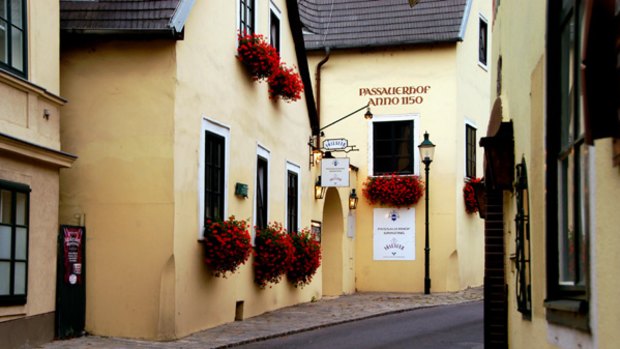
Vienna's blithe spirit ... a heuriger in Grinzig.Credit: David Ryan/Lonely Planet
Kevin Gould finds the best place for a tipple is one of Vienna's traditional wine taverns.
You thought it was all waltzes and wiener schnitzels? Vienna is alsoabout wine. More than that, Vienna is the only world capital with a serious wine industry.
Within the city limits, Vienna has 700 beautiful, visitable hectares of vineyard and 320 wineries. Put these together with a new breed of forward-looking vintners, add Austria's commitment to organic farming and the city's surprisingly affordable wine taverns and you have my hot tip for Europe's coolest wine destination - and the perfect place for a tipple.
As a city of classical culture, Vienna has it all: symphony halls, opera houses and art galleries all dressed up in mighty architecture. Frau Koch, my informative (if arch) guide, walks me briskly through the Museum Quarter, talking of crown prince this and empress that. The sense of God-given power emanating from all these imperial statues and wedding-cake edifices carries with it the stale whiff of pomp, designed to keep plebs like me in our place.
At Schwarzenbergplatz, outside the Wiener von Welten Palace, there is a tiny vineyard. Here, Frau Koch informs me that a) the lord mayor is a socialist and b) the socialist is also a winemaker: he ceremonially picks the grapes from this vineyard with his own hands. The city also owns 35 hectares of prime vineyard in the bucolic 19th district, our next stop.
After a 15-minute ride on the Green Line tram and a short bus ride uphill, we are ready to start the 10-kilometre walk to Neustift am Walde. Along the way we will pass through the villages of Nussdorf, Sievering, Cobenzl and Grinzing. The Viennese wine region straddles both banks of the Danube. From up here in the hills, the forest and vines are clothed in autumn gold and Vienna's vaulted sky is lapis-lazuli blue.
This afternoon, the Vienna hills are alive with the sound of Gore-Tex-clad peripatetic wine drinkers. The city's spires, houses and towers are spread far below us like so much Enlightenment Lego. With its grassy inclines and wooded dips, the wine trail offers the opportunity for serious exercise and serious drinking. What the bierhalle is to er, beer, the heuriger (plural, heurigen) is to wine. Heurigen punctuate the wine trail every few hundred metres: there are hundreds of them all over the city as well.
A heuriger is always family-run and exists to sell the wine produced by that family. You know when one is open by the bunch of pine branches displayed over its front door. In 1784, emperor Franz Joseph decreed that winemakers be allowed to sell their own wine from home and with food, too. You sit at a suitably rustic pine table, surrounded by, say, pairs of ice skates, old photos of whiskery men, whiskery old men with noses like pomegranates, antlers, amusing slogans describing how yesterday's inebriation does not remember today's thirst, or happy smiling people, sometimes with their dogs. Having bridled a bit at her pursed, prim city centre, I feel that in the heurigen I've found Vienna's blithe heart.
Heurigen can hold anything from eight to 800 people. In the larger establishments, your waitress will be wearing a traditional dirndl-type arrangement and, invariably, a welcoming smile. You order young white wine, or the red if you like thin, tart, acid wine. Many people will be drinking a spritzer, which is half wine, half soda water. A quarter-litre of any of these is no more than €2.50 ($4.60) and usually a bit less. Quality ranges from very good to truly excellent. For a euro or two more, you choose from a huge array of cheeses, meats and delicious fresh breads: many places also offer hot food like wiener schnitzel and, in November, roast goose and potatoes.
The grape's harvest and pressing is celebrated around these parts in November and from then until Christmas Day, heurigen are in full swing, as Vienna celebrates the season with dozens of Christmas markets. The most famous of these, outside the town hall, has been running since 1296 and is open daily until 9.30pm. Better, though, is to explore further afield: markets and Christmas "villages" spring up around the city in small squares, cul-de-sacs and alleys, where wooden huts dispense chilled white wine, hot punch and gluhwein, grilled sausages and sugared almonds.
The village of Grinzing is famous for its heurigen, though some can be a bit coach-party. For an authentic, large, multi-roomed heuriger, head away from the main drag to Hengl-Haselbrunner (Iglaseegasse 10, +4313203330, hengl-haselbrunner.at). People have drunk here since 1683 and the church next door is where Beethoven realised he was going deaf. I get blind drunk.
I also loved the front-room homeliness of Gabriella and Friedl Schoell's place (Cobenzlgasse 108, eccentric opening times - check first on +4313206907 and at buschenschankschoell.at). Up an unassuming flight of steps, the Scholl's alcove seat doubles as the wine press. Conversation flows readily between tables. This is lubricated by my hostess, Gabriella, and also in October and November by sturm, a semi-fermented new wine that tastes deliciously of sharp fruit juice but has a kick like Arnold Schwarzenegger. Frau Koch and I spend happy hours drinking biodynamic sturm. Austria's dominant wine grape is gruner veltliner, known locally as gru-vee. More archduke than Rio, Vienna isn't groovy but her wines are truly cool.
Guardian News & Media
Sign up for the Traveller Deals newsletter
Get exclusive travel deals delivered straight to your inbox. Sign up now.